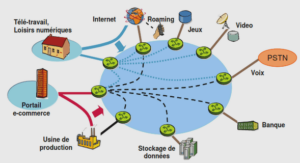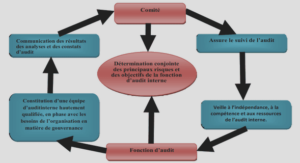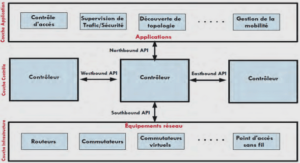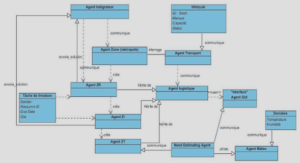CONSIDERATIONS IN THE DEVELOPMENT OF CRITERIA FOR SHARING BETWEEN THE TERRESTRIAL FIXED SERVICE AND OTHER SERVICES
One of the functions of a radiocommunications planner is to design and implement a transmission network which meets the performance objectives laid down by the ITU-T and ITU-R. It is important, therefore, that real systems can meet the appropriate design objectives, recognizing the increasing use of the radio spectrum. There are various ITU-R F-Series Recommendations which relate to the overall performance objective for various types of circuit.
Table 1 gives details of the error performance and availability objectives applicable for high-grade, medium-grade and local-grade portions of an integrated services digital network (ISDN) connection at bit rates below the primary rate utilizing digital radio-relay systems. In addition, the factors to be taken into account when determining error performance objectives for constant bit rate digital paths at or above the primary rate carried by digital radio-relay systems which may form part or all of the international or national portion of a hypothetical reference path are given in Recommendations ITU-R F.1092 and ITU-R F.1189 respectively.
The previous section dealt with the overall performance objectives for digital and analogue reference connections. However, there are, in practice, a large number of potential sources of interference contributing to the degradation of performance of a radio-relay system. In order to move towards a practical method for planning, the overall performance objectives need to be sub-divided between individual sections of the overall HRC. Within a section, the performance objective is then apportioned between the various sources.
Apportionment of section performance objective
This is covered in Recommendation ITU-R F.1094. The allowable degradation is divided into an element of X% for the FS portion, Y% for frequency sharing on a primary basis, and Z% for all other sources of interference (it should be noted that X% Y% Z% 100%). In the case of sharing with the fixed-satellite service (FSS), typically, Y 10% (e.g. Recommendation ITU-R SF.615).
There may be a further sub-division of the X% allowance to suit local requirements and this could be apportioned in such a way as to suit the grade of service.
A particular point to note is that an interference source (say a transmitter (Tx)) may affect more than one hop of a system.
Characteristics of interference
It is necessary to have information available on interference levels arising from other services, which would degrade system performance by specific amounts. This would be facilitated if, with the assistance from other Study Groups, a table were compiled giving information on the characteristics of emissions.
– the interference arising from services sharing on a primary basis that is likely to be within the receiver (Rx) bandwidth from analogue or digital modulations, in either carrier wave or burst emissions. Reference can be made to existing text where available in ITU-R F-Series and SF-Series Recommendations (e.g. Recommenda- tion ITU-R SF.766);
– emissions from systems other than those sharing on a primary basis that could be numerous and diverse, and may be considered in a similar way to the spurious emissions.
Ultimately, another table could be prepared, again with the assistance of other Radiocommunication Study Groups, which compares levels of interference or Gaussian noise required to produce a specified degradation in the channel performance.
Following the considerations in the previous sections, one may now determine the limit values of interference allowable to a particular source. This has been done for the case of frequency sharing between the FSS and the FS in the joint workings of Radiocommunication Study Groups 4 and 9, where certain models have been established. These models may be appropriate for frequency sharing between radio-relay systems and other services in general.
Methods for characterizing interference levels into terrestrial radio-relay systems include power flux-density (pfd), power level at the input to the antenna or the power level at the receiver input. It is worth noting that both methods are in use in ITU-R SF-Series Recommendations.
A single interference limit value is not adequate because of the time varying nature of the interference. Two limit values, corresponding to a long term (20% of time) and a short term (1% of time) have been identified in Recommendation ITU-R SF.1006. The exact value of the short-term time percentage is related to the performance objectives for the system under consideration. Radiocommunication Study Groups 4 and 9 have developed this method for the specific purpose of sharing between the FS and the FSS. Further study is needed to determine the extent to which the techniques developed in Radiocommunication Study Groups 4 and 9 are applicable to the other cases. Table 3 lists the references relating to sharing between the FS and the FSS, concerning interference into the FS.




